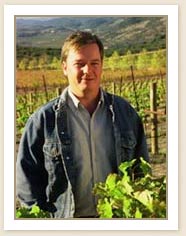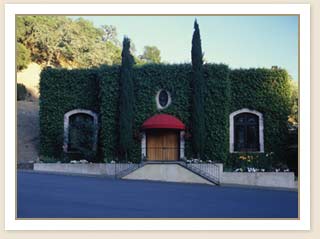
 Although this last trip to celebrate the Lewis's 20th anniversary was a short one and I just wanted to relax. Whenever I make a trip to Napa I stop by and see Rob Sweeney at Vine Cliff Winery.
Although this last trip to celebrate the Lewis's 20th anniversary was a short one and I just wanted to relax. Whenever I make a trip to Napa I stop by and see Rob Sweeney at Vine Cliff Winery.
It was Sunday before the big bash with Lewis's and I called to see what Rob was doing. It was around noon and Rob was on the way to the winery to water the vines. So, I offered to help of course. There are not many owners like Rob that will take it upon himself to do this seemingly menial task- especially on a Sunday. And when I heard that we had to manually open the water supply at each section of the vineyard, I was a bit confused as to why he did not automate this process, so he could just push a button to turn the water on and off.
As we drove through the vineyard on 4 wheelers, Rob pointed out various sections of vineyard that we would be watering. The driving on 4 wheelers was the best part of the visit for me, Vine Cliff has some very steep vineyards and the only way you can get to some of these rows to turn on the water supply is by off road vehicle or horseback. I am glad they got rid of their horses some time ago as I am not a very good horseman.
Some parts of the wine world frown on watering as the Biodynamic farming doctrine says that the level of water in the vineyard is part of that terroir and should not be adjusted. The root system of the vine will go deeper to pull up the nutrients and therefore give the wine more concentration of these mineral characteristics.
But, as Rob explained, if you do not water in Napa Valley on the hillsides you will not have grapes. The rainfall here during crucial times of the vines growing cycle is so minimal that the vine would not support any fruit at all without irrigation. The secret in Napa is to stress the vines just enough that their root system goes as deep as possible.
The precision in which you water grapevines was very interesting to me and at Wine Cliff Winery they have a schedule for each block of the vineyard that gives exact times to water. This is more scientific than I imagined, there are many variables such as wind, humidity levels and of course temperature. In addition to these variables, they also have a little machine that checks the plants stress level in terms of how bad it needs water. This test takes one of the plants leaves that is fully exposed to the sun, this leave is placed in a vacuum chamber and then put under pressure till the leaves tell you it is stressed by the stem bubbling up a bit of water. Our hydrometer should have been reading at 8-10, but these plants were a bit more stressed than expected and were pulling readings in the 15 range.
This is why you have to do these tests, it could have been due to the windy weather or another variable but it is impossible to tell for sure if you are watering at the right time without this type of equipment.
We drove up and down the hills turning on water and testing the leaves to see the level of stress in several areas of the vineyard. This process took around 2 hours to do and although Rob's vineyard manager Juan was on the phone with Rob on his day off because of the higher than expected numbers. Juan works 6 days a week and Rob likes to make sure he gets at least one day off but wanted to make him aware of the results to make sure he adjusts the water requirements the following day.
This kind of attention to detail and hard work starts at the top and when you lead by example like this you know your staff will work harder and his people care for the vines at Vine Cliff just like he does- like it is their vineyard.
After we finished our watering duties it was time for lunch and the reason why the food is so good in Napa Valley is the raw materials. Rob gathered some tomatoes, Lemon cucumber and some heirloom melon from his garden at the winery and quickly turned in to a salad with a yuzu dressing. I know that most people traveling to Napa like to check out the local restaurants but to me there is nothing better than a home cooked meals.
So I may be biased when I say that Rob is making some of the best wines in Napa Valley, but for scientific purposes I have put both the Oakville Estate and Private Stock into blind tasting with their neighbors: Screaming Eagle, Dalla Valle, Harlan Estate and Schrader- all of these wines costing at least twice the price or more...and Vine Cliff always shows among the top wines on the table.
In addition to the Cabernet Sauvignon produced here, the Chardonnay is also top level with their newest release one of the best wines that I have tasted from California from the 2009 vintage. Check out all the older vintage Vine Cliff we have at the end of this offering as well.
A little history of Vine Cliff Winery:
t took close to 85 years before Vine Cliff, like the phoenix in its seal, rose from the ashes. Chuck and Nell Sweeney, along with their son Rob are tireless hosts with an appetite for hard work, long hours, good food and great wine. Their love of fine wines turned them into zealous collectors, and they became familiar and generous faces at the Napa Valley Wine Auction. In 1985, the Sweeneys' hobby turned serious when they bought a rugged, 100-acre parcel in the eastern hills of Napa Valley along the Silverado Trail. Vine Cliff Winery was borne out of the Sweeneys' love and dedication to the production of fine wines. The labor of love continues. The original winery was resurrected in 1990 and 1991 with the construction of barrel chais. In 1995 the gravity fed production facility was completed and is considered one of the top production facilities in California. Additional vineyards were purchased in Calistoga, Carneros and Howell Mountain. Today, Vine Cliff has over 40 acres of estate vineyards. In 2000, the construction of 15,000 square feet of caves for barrel aging of the red wines was completed.
The Vine Cliff Estate of today is an exquisite mountainside property located on land which was once part of the original George C. Yount estate. Noteworthy locals George Burrage and Thomas Tucker purchased the site for Vine Cliff Winery from the Yount Estate in 1871 (five years after Yount's death). Burrage and Tucker built Vine Cliff into what appears to be the largest winery in the Napa Valley. After the deaths of Burrage and Tucker, wealthy San Franciscan John Fry bought the property and immediately set out to achieve his vision for the winery, which he did by the 1890's. Fry had made a fortune in Nevada silver and invested heavily in San Francisco real estate. He served on the board of directors of a dozen major companies, including the Bank of California and the Napa Valley Wine Company. A half-dozen wineries were affiliated with the Napa Valley Wine Company, the leaders of which wanted to build name recognition for the company by setting a quality standard with its wines, unmatched in California. In 1886 the company began building a huge wine cellar at Vine Cliff - 60 by 150 feet - which was to be the principal cellar for the allied producers of wine. Vine Cliff wines were considered the reserve wines of the Napa Valley Wine Company.
As Vine Cliff Winery prospered, it attracted the social set of San Francisco. Prominent San Franciscans visiting Vine Cliff included William Ralston, the founder of the Bank of California. Amazingly, the early history of Vine Cliff is contained within a short thirty years. Phylloxera destroyed the vineyards and supporting wine production by about 1900. It would seem that after Fry's death in 1901, most of the winery structure disappeared in a matter of a few years, with the exception of the stone first floor and tunnels.
The Sweeney Family continues the vision of Vine Cliff founders Burrage and Tucker, and that of Col. Fry - to produce outstanding and distinctive wines and to create a landmark where the incredible beauty of this historic hillside setting is to be enjoyed and where the legacy of Vine Cliff lives on into its third century. The Oakville Estate vineyard consists of a total of twenty-two acres of vines on the one hundred acre estate. This is also the location of the Winery, Caves and Sweeney family home that is featured on the Vine Cliff wine label.
Situated about three hundred and fifty feet above the Silverado Trail on the East side of the Napa Valley is a plateau called the Oakville Bench. On this portion of the estate is eight acres of Cabernet Sauvignon. The balance of the estate's vines are planted on terraces starting just above and East of the Trail, both to the North and South of the main drive. These are also planted to Cabernet Sauvignon. Additionally, between the two lower Cabernet blocks, close to the North side of the drive, two acres of Merlot are planted.
The Oakville Estate vineyard, originally planted in the 1870s, but destroyed by Phylloxera in the 1890's, was replanted by The Sweeney Family in 1985-1987 with AXR-1 rootstock vines. These unfortunately became infested with Phylloxera, and replanting with certified resistant rootstock began in 1990, at a density of about 1,340 vines per acre, on nine vineyard lots. This replanting enabled the old vines to be replaced with exactly suited varietals, clones, rootstocks, and trellising and irrigation systems.
Vine Cliff has three other vineyards in addition to the Oakville bench property. The Carneros Vineyard consists of twenty-acres located on Carneros Creek. It was planted with 13 acres of Chardonnay in May of 1999. It will ultimately have about eighteen acres of the twenty total planted with Chardonnay. The Calistoga Vineyard is located a few miles south of Calistoga, on the east side of the Silverado Trail, about fifteen miles north of the winery. It is adjacent to the famous Eisele Vineyard and is planted to five acres of Cabernet Sauvignon and one of Cabernet Franc. Situated on hilly terrain, some of the vineyard is terraced, while the rest is sloping. And finally the Howell Mountain Vineyard latest vineyard project is a choice site on the higher elevations of Howell Mountain. During the growing season, this vineyard will often be above the fog that can envelop the valley floor. With its south facing slopes and excellent exposure, this vineyard is perfectly suited to Cabernet Sauvignon and other red Bordeaux varieties. The deep iron-red volcanic soils will allow Vine Cliff to ultimately dry farm the vineyard. Protecting this unique environment will also be a main focus of Rob Sweeney's plans for this vineyard. Wines from the Howell Mountain Appellation have long been acclaimed as being very powerful and concentrated, and this great region will round out our estate vineyard program.
Since 1990 all of Vine Cliff's vineyards have been managed according to the principles and practices of Sustainable Viticulture. This has meant that, where possible, no pesticides, herbicides or artificial fertilizer have been used on the vines for almost a decade. Additionally, ten tons of plant materials are returned to the soil as compost annually. The vineyards have native species of grasses planted as ground cover between the rows of vines. These are never plowed under but only cut; allowed to naturally compost and further enrich the soil. The most ecologically complex and diverse biosystem has been established over the years resulting in natural control of plant pests and diseases.
Vine Cliff Winery's picturesque twelve-acre Estate Chardonnay vineyard is in the heart of the Los Carneros appellation. The Los Carneros appellation is ideal for growing Chardonnay because of its cooler climate. The cool foggy mornings in conjunction with the afternoon breezes off San Pablo Bay allow the grapes to have a longer than average hang time for flavor development, while still retaining higher natural acidity.
























